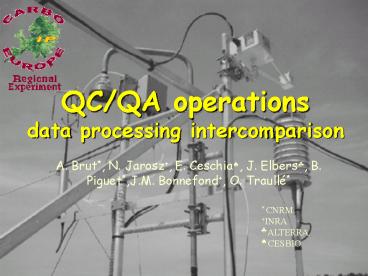QCQA operations data processing intercomparison PowerPoint PPT Presentation
1 / 13
Title: QCQA operations data processing intercomparison
1
QC/QA operations data processing intercomparison
- A. Brut, N. Jarosz, E. Ceschia?, J. Elbers?, B.
Piguet,J.M. Bonnefond, O. Traullé
CNRM INRA ? ALTERRA ? CESBIO
2
Context and Objectives
- Importance of data processing and flux
computation in the framework of CarboEurope-IP
and FLUXNET to improve turbulent flux estimates
obtained with the eddy covariance method - To evaluate the differences in flux computation
softwares - To detect weaknesses in data processing and
improve the reliability of flux estimates
3
Data and methods
- 3 summer days from Le Bray Tower (thanks to
Nathalie Jarosz) - Golden files from 5 CarboEurope sites
intercomparison still in progress (thanks to Jan
Elbers) - Different sites, different instruments (sonic
anemometers, fast sensors for H20/CO2) - Eddy covariance method Fc ltwcgt
- But different ways to obtain fluctuations and
to correct for errors (instrumental/theoretical)
4
Steps of flux computation
- 1. Identification of spikes
- 2. Corrections for cross-wind, time lag between
sensors - 3. Calculation of rotations and averages
- 4. Covariance calculation
- 5. Spectral corrections after Moore (1986)
- 6. Density corrections for scalar fluxes (Webb et
al., 1980) - 7. Final unit conversions
- Gap filling
- Quality control
5
Results intercomparison
- A few statistics
TEAMS INRA CESBIO ALTERRA CNRM U
R² 0.99 R² 0.99 R²0.99 R²0.99 slope a
1.01 a 0.93 a 1.01 a 1.04 Hs
R² 0.99 R² 0.99 R²0.96 R² 0.98
a 1.02 a 0.9 a 1.01 a 1.05
Le R²0.99 R²0.98 R²0.98 R²
0.96 a 0.94 a 0.87 a
1.05 a 0.97 Fc R² 0.97 R²0.95
R² 0.91 R² 0.93 a 0.99 a
0.84 a 1.06 a 1.10
6
Results friction velocity
7
Results friction velocity
- - mean values over the 3 days
- INRA 0.453 m/s
- CESBIO 0.429 m/s
- ALTERRA 0.451 m/s
- CNRM 0.457 m/s
- total mean value 0.45 0.012 m/s (3)
8
Results sensible heat flux
- mean values over the 3 days
- INRA 48.9 W/m²
- CESBIO 39.3 W/m²
- ALTERRA 51.6 W/m²
- CNRM 49.1 W/m²
- total mean value 47.2 5.4 W/m² (10)
9
Results latent heat flux
- - more noise on data
- - mean values over the 3 days
- INRA 100.5 W/m²
- CESBIO 93.6 W/m²
- ALTERRA 109W/m²
- CNRM 97.9 W/m²
- total mean value 100.3 6.6 W/m² (6)
10
Results CO2 flux
- - mean values over the 3 days
- INRA -3.5 µmol/m²/s
- CESBIO -2.6 µmol/m²/s
- ALTERRA -4.7 µmol/m²/s
- CNRM -3.4 µmol/m²/s
- total mean value -3.55 0.86 µmol/m²/s (25)
11
Results energy budget
- Latent sensible heat fluxes versus net
radiation - high scatter for CNRM data
- low value for the slope of linear fit for CESBIO
12
Conclusions
- On average, good results for friction velocity
but rather large scatter for CO2 fluxes - For a particular meteo event different flux
estimates large discrepancies between flux
algorithms lead to discrepancies of turbulent
fluxes - In general - high scatter for CNRM data
- - weaker fluxes for CESBIO
- - higher flux values (on average) for
ALTERRA
13
Suggestions
- Follow all the recommandations of the 1st
CARBOEUROPE QC/QA meeting to calculate the
turbulent fluxes - Go on the investigation with the Golden files
- Validation of the data using quality control
tools (ogive functions, turbulent parameters etc
) - Others ???

